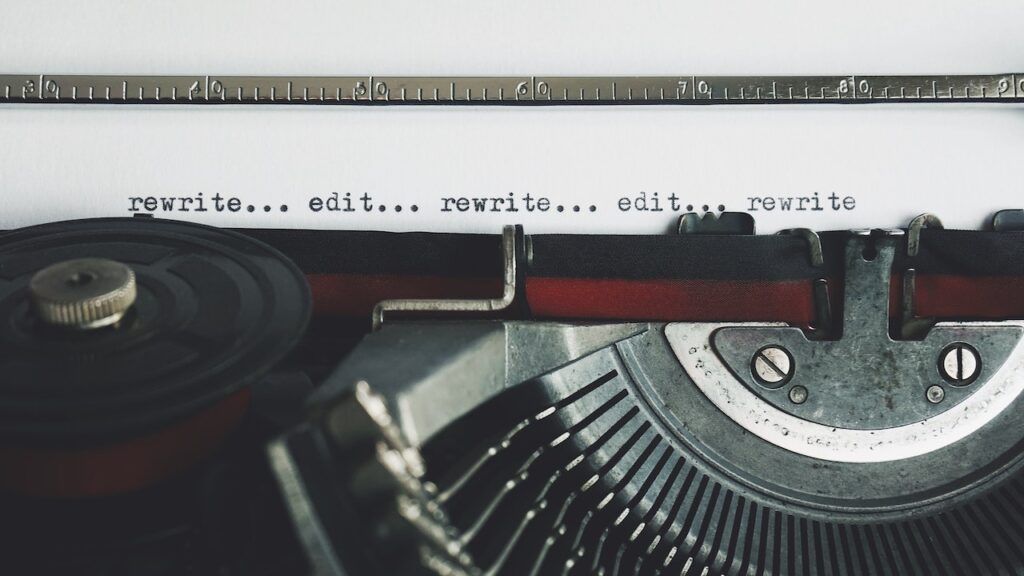Writing
Self-Editing Like a Pro: From First to Final Draft
Self-editing is an essential skill for any writer to have in their tool belt. With the right tools, you can be a master of self-editing and take your manuscript from first to final draft in no time.
Knowing how to effectively self-edit is a great skill to cultivate, no matter your publishing goal. Not only will it give your manuscript the best chance at success, whether that be landing an agent or finding a readership, it will also save you time and money if you plan to hire a professional editor in future by cutting down on the work they’ll need to do to get your novel in tip-top shape.
Here are the top self-editing tips I’ve learned over my years as a writer and editor:
Step away before editing
The first step to self-editing your novel is taking a break from it. The idea is that you allow yourself some time away from your manuscript so that when you return, you’ll have a fresh perspective and won’t be staring at it with tunnel vision.
It’s easy to get caught up in a project. You spend so much time and emotion on what you’re writing that it can be difficult to be objective about it if you just dive straight in.
I always recommend a complete break. Do something to cleanse your palate, like read a book from another genre or start outlining a new project with a different world and characters. The trick is to get your head out of your project so you can be as disconnected and dispassionate about it as possible.
Giving yourself some much-needed time away from your manuscript increases your chances of picking up on mistakes you might have missed otherwise. The obvious is often easy to overlook when you’re familiar with something. A bit of distance means you’ll be much more thorough on the first re-read.

Read first, edit later
To ensure your pacing and flow are on point, it’s important to read through from start to finish without doing any editing. I know this feels counter-intuitive, but it’s good to get a sense of the narrative as a whole before making any changes. By all means, bookmark sections you feel you might need to revisit, but don’t actually edit anything. Just keep those sections in mind.
On your second reading, you’ll be able to keep an eye out for any scenes that feel rushed and try to figure out how they could be improved. It’s easier to pick these up in context if you’ve already got a feel for the full manuscript from a reader’s perspective. If there are parts of the story that drag on too long, think about adding more excitement or tension. If you’ve marked them off in context, you’ll have a clearer picture of where and how these fit in the wider narrative.
When self-editing, you’re trying to emulate what a professional editor would do. Your job is not just to fix mistakes but also to improve the story as a whole — and when you read through your manuscript with this mindset, you may notice things you otherwise would have missed!
Read out loud
Hearing your work read aloud can change the way you view it. It can highlight things you might have missed otherwise, like sections that don’t have the right flow or stilted dialogue. It also makes it easy to pick up on run-on sentences and unnecessary tangents.
You can read it out loud to yourself, but this can be time-consuming (and get you funny looks if you’re doing it in public). Thankfully, text-to-speech technology has come a long way. Most mobile devices will have text-to-speech software native to their OS, but you can also get browser extensions that will read directly from your browser window that you can use to read your text directly in Novlr. You can also download third-party software that you can feed documents to read back to you.
Hearing a human read your work is always the best solution, so if you have a friend or a loved one willing to give up their time to do a couple of reading sessions with you, that’s ideal. But for those who want to go it alone, text-to-speech is a great solution, especially if you want to edit on the go.
A change of format is a surefire way to pick up on errors, inconsistencies, and other narrative quirks that might have remained hidden, including highlighting if your sentence length is varied and interesting.

Use a proofreading app
Proofreading and grammar-checking apps aren’t foolproof, but they can be a great way to streamline the tedious process of proofreading. By highlighting potential mistakes, it makes the process much quicker, allowing you to concentrate on the more fun and important editing tasks.
Apps like ProWritingAid and Grammarly analyse your writing and suggest corrections for any mistakes they find. They are great for catching some of the more common errors that might slip past you when reading over your work. In fact, Novlr Pro users have ProWritingAid integrated directly into Novlr, so you can even check these basics as you go!
As much as they’re a great tool, however, they are no substitute for a good working knowledge of spelling, grammar, and narrative convention. They make great guides, but not every correction should be taken as gospel, as there is no way to automate every nuance of creative writing.
Remove common errors
There’s no avoiding multiple read-throughs when self-editing. You should always set aside time for targeted revisions that look for specific things you should cut.
When you do a targeted sweep, you should specifically look out for common errors that can bring down the quality of your writing. These include:
- overuse of passive voice
- misplaced cliches
- inconsistent PoV
- inconsistent use of tense
- crutch words and phrases
- excessive use of adverbs
Inconsistent tone, tense, and PoV are the most glaring mistakes, so they are usually easy to spot. Crutch words and phrases should also be simple to nail down once you’ve read through your manuscript as a whole.
Cliches and passive voice can be a little trickier, however, as they can also fall into the category of stylistic choice. Characters might regularly use cliches in their speech, for instance, making it an integral part of your story. And past continuous tense is often incorrectly flagged as passive voice, especially by proofreading apps.
Here are some quick examples of past, past continuous, and passive voice to help you spot the difference:
Past: I ate the soup (it was actively eaten in the past)
Past continuous: I was eating my soup (it happened in the past, but is a continuing action)
Passive voice: The soup was being eaten by me (the soup has no active agency in whether it is eaten)
Past continuous tense can be annoying to read if overused, so it’s still good to limit its use if possible. But knowing what to look out for and being able to clearly see the difference between past, past continuous, and passive voice will help you define what needs cutting and what is worth keeping.
Scanning for crutch words and phrases also requires a bit of self-reflection. You have to be willing to remove yourself from the project and analyse the way you write from a birds-eye view rather than just going with the flow of the story. This is when reading aloud becomes a valuable part of your editing process.
But sometimes, just changing the format helps. Download your manuscript to read on the go, convert it to epub to read on a device, or even print it out in hard copy. A different format can change the reading experience, making it easier to spot common repetitions.
Trim the fat
When editing a manuscript, you should look for parts that don’t necessarily add to the story. These could be tangents, needless descriptions, or entire chapters that can be easily cut without causing a dramatic shift in the narrative.
These types of edits should be approached with a light touch, however. If it doesn’t serve the story, cut it out — but don’t be too brutal. You don’t want to sacrifice essential world-building or character development by being too heavy-handed.
Most essential cuts will come from eliminating redundancy (for example: if a character says something in one scene but then repeats it later on), or plot elements that don’t serve the story as a whole.
Ultimately, the goal of self-editing is to trim the fat and improve the quality of your work. Cut what doesn’t serve the plot, and keep what adds texture.

Find beta readers
Beta readers are an essential part of the editing process. My top tip is to have two groups of beta readers for different draft stages: The first for after the initial proofreading and removal of crutch words so they can focus on character and plot development, and the second to look over your almost-completed manuscript to pick up on anything last-minute.
However, at whatever stage you get beta readers, ensure they’re unbiased. You want readers who will approach your manuscript with completely fresh eyes and no preconceived ideas of what your story is beyond a blurb and the genre.
Having these kinds of readers lets you get a truthful view of what’s working and what’s not. It also helps with consistency, as each reader will approach a story differently, giving you more insight into how your book might be received by a wider audience. Their feedback is also invaluable in determining if there are any significant problems with pacing or flow within the novel itself. Writers often fail to approach their work dispassionately and objectively, so beta readers are your best chance at pinpointing fundamental story flaws and an integral part of the self-editing process.
Don’t delete anything
When you do any writing at all, do not delete anything. Even when cutting things from your narrative, removing repetition, or excising irrelevant detail, keep everything.
Save each edit of your work as a new version because you never know when you might need something as inspiration for another project or need to refer back to some world-building.
Once you delete your words, that’s it. They’re gone.
You might never use those words again, but it’s better to keep them and never need them than delete them and have to rewrite them.
Editing your own novel is a lot of work, but the payoff is huge. It can help you improve as a writer and ensure you present your best work to agents, publishers, and readers. Self-editing isn’t a substitute for a professional editor (especially if you’re self-publishing), but it’s a great step in the right direction. Being diligent and structured in how you approach the process will give your work the best chance at success.